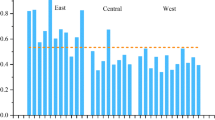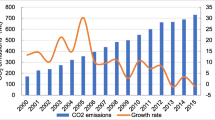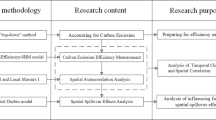Abstract
The total factor CO2 emission performance (TFCEP) of transportation industry has received increasing research interests, while existing literature pays little attention to its regional inequality and driving factors. In order to uncover the regional inequality of TFCEP in China’s transportation industry, this paper used Theil index and combined with geographical detector model (GDM) to explore the driving factors and their interactions on TFCEP in Chinese transportation industry. The results revealed that the TFCEP of transportation industry showed a promising increase during 2003–2017 with an annual growth rate of 0.12%, and the improvement was contributed by the technical efficiency change. The TFCEP in the Eastern region performed better than that in the Northeast, Central, and Western region. Regional inequality of TFCEP did exist and exhibited an obvious downward trend. The within-region inequality had a greater impact on the inequalities than between region. Freight turnover was the main driving factor of TFCEP in the transportation industry, followed by the energy intensity and per-capita GDP. In the Eastern and Western regions, freight turnover had the greatest impact on TFCEP, while in the Central and Northeastern regions, urbanization rate and energy intensity were the dominant factors, respectively. The interactions between energy intensity and freight turnover were highly influential. This paper provides important insights for different regions to formulate targeted carbon emission reduction policies.






Similar content being viewed by others
Availability of data and materials
The datasets used and/or analyzed during the current study are available from the corresponding author on reasonable request.
Abbreviations
- DMU:
-
Decision-making unit
- PPS:
-
Production possibility set
- ML index:
-
Malmquist–Luenberger productivity index
- GML index:
-
Global Malmquist–Luenberger productivity index
- TFCEP:
-
Total factor CO2 emission performance
- TC:
-
Technical change index
- EC:
-
Technical efficiency change index
- GDM:
-
Geographic detector model
- EI:
-
Energy intensity
- GDP:
-
Gross domestic product
- PGDP:
-
Per-capita GDP
- POP:
-
Population
- UR:
-
Urbanization rate
- FT:
-
Freight turnover
- PT:
-
Passenger turnover
References
Alcantara V, Duro JA (2004) Inequality of energy intensities across OECD countries: a note. Energ Policy 32:1257–1260
BP (2019) Statistical Review of World Energy. BP
Cao W, Yuan X (2019) Region-county characteristic of spatial-temporal evolution and influencing factor on land use-related CO2 emissions in Chongqing of China, 1997-2015. J Clean Prod 231:619–632
Chen JD, Xu C, Song ML, Xie QJ, Liu X (2019) Regional disparities and influencing factors for carbon productivity change in China's transportation industry. Int J Sustain Transp 14:1–2
Clarke-Sather A, Qu J, Wang Q, Zeng J, Li Y (2011) Carbon inequality at the sub-national scale: a case study of provincial-level inequality in CO2 emissions in China 1997–2007. Energy Policy 39:5420–5428
Dai Y, Gao HO (2016) Energy consumption in China’s logistics industry: a decomposition analysis using the LMDI approach. Transport Res D-Tr E 46:69–80
Du Q, Li J, Li Y, Huang N, Zhou J, Li Z (2020) Carbon inequality in the transportation industry: empirical evidence from China. Environ Sci Pollut Res 27:6300–6311
EIA (U.S. Energy Information Administration) (2010) International energy outlook 2010
Fan FY, Lei YL (2016) Decomposition analysis of energy-related carbon emissions from the transportation sector in Beijing. Transport Res D-Tr E 42:135–145
Fan MT, Shao S, Yang LL (2015) Combining global Malmquist-Luenberger index and generalized method of moments to investigate industrial total factor CO2 emission performance: a case of Shanghai (China). Energ Policy 79:189–201
Färe R, Grosskopf S, Pasurka CA Jr (2007) Environmental production functions and environmental directional distance functions. Energy 32:1055–1066
Guan W, Xu ST (2015) Spatial energy efficiency patterns and the coupling relationship with industrial structure: a study on Liaoning Province, China. J Geogr Sci 25:355–368
Guo Y, Zhang X, Wang Q, Chen H, Du X, Ma Y (2020) Temporal changes in vegetation around a shale gas development area in a subtropical karst region in southwestern China. Sci Total Environ 701:134769
Guo P, Wu H, Chen Y, Lv J, Shi T, Liu P, Wu Y, Zhou H, Zhang H, Liu M, Zheng M, Feng W (2021) Associations of chemical components of fine particulate matter with emergency department visits in Guangzhou, China. Atmos Environ 246:118097
He CH (2012) Research on low carbon traffic development of Shanghai based on the LMDI model. Hefei University of Technology (in Chinese), Heifei, 28 pp
Heil MT, Wodon QT (2000) Future inequality in CO2 emissions and the impact of abatement proposals. Environ Resour Econ 17:163–181
Hu Y, Wang J, Li X, Ren D, Zhu J (2011) Geographical detector-based risk assessment of the under-five mortality in the 2008 Wenchuan Earthquake, China. PLoS ONE 6
Hu N, Liu S, Gao Y, Xu J, Zhang X, Zhang Z, Lee X (2018) Large methane emissions from natural gas vehicles in Chinese cities. Atmos Environ 187:374–380
Li J, Xu C, Chen M, Sun W (2019) Balanced development: nature environment and economic and social power in China. J Clean Prod 210:181–189
Lin BQ, Benjamin NI (2017) Influencing factors on carbon emissions in China transport industry. A new evidence from quantile regression analysis. J Clean Prod 150:175–187
Lin B, Fei R (2015) Regional differences of CO2 emissions performance in China’s agricultural sector: a Malmquist index approach. Eur J Agron 70:33–40
Liu Z, Li L, Zhang Y-J (2015) Investigating the CO2 emission differences among China's transport sectors and their influencing factors. Nat Hazards 77:1323–1343
Lu SR, Jiang HY, Liu Y, Huang S (2017) Regional disparities and influencing factors of average CO2 emissions from transportation industry in Yangtze River Economic Belt. Transport Res D-Tr E 57:112–123
Lv TX, Wu X (2019) Using panel data to evaluate the factors affecting transport energy consumption in China's three regions. Int J Env Res Public Health 16
National Bureau of Statistics of China (2011) Division method of East, West, Central, and Northeast China [Chinese document]. http://www.stats.gov.cn/ztjc/zthd/sjtjr/dejtjkfr/tjkp/201106/t20110613_71947.htm. Accessed 1 April 2021
Oh DH (2009) A global Malmquist-Luenberger productivity index: an application to OECD countries 1990-2004. The Royal Institute of Technology, Stockholm
Oh DH (2010) A global Malmquist-Luenberger productivity index. J Prod Anal 34:183–197
Peng Z, Wu Q, Li M (2020a) Spatial characteristics and influencing factors of carbon emissions from energy consumption in China’s transport sector: an empirical analysis based on provincial panel data. Pol J Environ Stud 29:217–232
Peng Z, Wu Q, Wang D, Li M (2020b) Temporal-spatial pattern and influencing factors of China’s province-level transport sector carbon emissions efficiency. Pol J Environ Stud 29:233–247
Ran Q, Hao Y, Xia A, Liu W, Hu R, Cui X, Xue K, Song X, Xu C, Ding B, Wang Y (2019) Quantitative assessment of the impact of physical and anthropogenic factors on vegetation spatial-temporal variation in Northern Tibet. Remote Sens 11
Ren Y, Deng L-Y, Zuo S-D, Song X-D, Liao Y-L, Xu C-D, Chen Q, Hua L-Z, Li Z-W (2016) Quantifying the influences of various ecological factors on land surface temperature of urban forests. Environ Pollut 216:519–529
Shan HJ (2008) Re-estimating the capital stock of China: 1952–2006. J Quant Tech Econ 10:17–31 (In Chinese)
Shorrocks AF (1980) The class of additively decomposable inequality measures. 48(3):613-625
Theil H (1967) Economics and information Theory, vol 7. North-Holland Publishing Company, Amsterdam
Wang J-F, Xu C-D (2017) Geodetector: principle and prospective. Acta Geograph Sin 72:116–134 (in Chinese)
Wang J-F, Li X-H, Christakos G, Liao Y-L, Zhang T, Gu X, Zheng X-Y (2010) Geographical detectors-based health risk assessment and its application in the neural tube defects study of the Heshun Region, China. Int J Geogr Inf Sci 24:107–127
Wang B, Sun Y, Chen Q, Wang Z (2018) Determinants analysis of carbon dioxide emissions in passenger and freight transportation sectors in China. Struct Chang Econ Dyn 47:127–132
Wang Q, Jiang X-t, Yang X, Ge S (2020a) Comparative analysis of drivers of energy consumption in China, the USA and India - a perspective from stratified heterogeneity. Sci Total Environ 698
Wang L, Xi F, Yin Y, Wang J, Bing L (2020b) Industrial total factor CO2 emission performance assessment of Chinese heavy industrial province. Energy Efficiency 13:177–192
Wang L, Fan J, Wang J, Zhao Y, Li Z, Guo R (2020c) Spatio-temporal characteristics of the relationship between carbon emissions and economic growth in China's transportation industry. Environ Sci Pollut Res 27:32962–32979
Xiao H, Shan Y, Zhang N, Zhou Y, Wang D, Duan Z (2019) Comparisons of CO2 emission performance between secondary and service industries in Yangtze River Delta cities. J Environ Manag 252:109667
Xu B, Lin BQ (2015) Carbon dioxide emissions reduction in China’s transport sector: a dynamic VAR (vector autoregression) approach. Energy 83:486–495
Xu B, Lin B (2018) Investigating the differences in CO2 emissions in the transport sector across Chinese provinces: evidence from a quantile regression model. J Clean Prod 175:109–122
Yin J, Wu X, Shen M, Zhang X, Zhu C, Xiang H, Shi C, Guo Z, Li C (2019) Impact of urban greenspace spatial pattern on land surface temperature: a case study in Beijing metropolitan area, China. Landsc Ecol 34:2949–2961
Yuan C, Zhang S, Jiao P, Wu D (2017) Temporal and spatial variation and influencing factors research on total factor efficiency for transportation carbon emissions in China. Resour Sci 39:687–697 (in Chinese)
Zhang N, Wei X (2015) Dynamic total factor carbon emissions performance changes in the Chinese transportation industry. Appl Energy 146:409–420
Zhang N, Zhou P, Kung CC (2015) Total-factor carbon emission performance of the Chinese transportation industry: a bootstrapped non-radial Malmquist index analysis. Renew Sust Energ Rev 41:584–593
Zhang L, Chen D, Peng S, Pang Q, Li F (2020) Carbon emissions in the transportation sector of Yangtze River Economic Belt: decoupling drivers and inequality. Environ Sci Pollut Res 27:21098–21108
Zhou GH, Chung W, Zhang XL (2013) A study of carbon dioxide emissions performance of China’s transport sector. Energy 50:302–314
Funding
This work was supported by Youth Innovation Promotion Association, Chinese Academy of Sciences [grant number 2020201].
Author information
Authors and Affiliations
Contributions
Li Wang: Conceptualization; Methodology; Data curation; Writing, original draft preparation; Visualization; Writing, reviewing and editing. Yanfei Zhao: Formal analysis; Investigation; Methodology; Writing, reviewing and editing. Jiaoyue Wang: Conceptualization; Supervision; Funding acquisition; Writing, reviewing and editing. Jiahui Liu: Data curation; Methodology; Software; Validation; Visualization; Writing, original draft preparation. All authors have read and approved the paper.
Corresponding authors
Ethics declarations
Ethics approval
Not applicable.
Consent to participate
Not applicable.
Consent for publication
Not applicable.
Competing interests
The authors declare no competing interests.
Additional information
Responsible Editor: Eyup Dogan
No part of this paper has been published or submitted elsewhere.
Publisher’s note
Springer Nature remains neutral with regard to jurisdictional claims in published maps and institutional affiliations.
Rights and permissions
About this article
Cite this article
Wang, ., Zhao, Y., Wang, J. et al. Regional inequality of total factor CO2 emission performance and its geographical detection in the China’s transportation industry. Environ Sci Pollut Res 29, 3037–3050 (2022). https://doi.org/10.1007/s11356-021-15613-8
Received:
Accepted:
Published:
Issue Date:
DOI: https://doi.org/10.1007/s11356-021-15613-8




